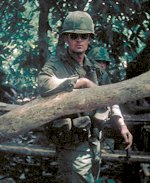
James John Magner
First Lieutenant/Captain, 2-18 Infantry, 1st Infantry Division
March 1966-March 1967
I may have been the only infantry platoon leader in Vietnam with an art degree. Artist/soldier: a lifelong dichotomy, if not a severe personality conflict. As a child in a tough Chicago neighborhood, I had to fight just to cross the street, but could see beauty in the rainbow colors of an oil slick.
After moving to Arizona, I spent many hours drawing in the high Sonoran Desert and its rugged mountains—when I wasn’t going to war movies or getting in trouble.
An art major at the University of Arizona, I was also in the ROTC advanced program. My art professors weren’t comfortable with the uniform, and my Army cadre wasn’t happy with the paint stains. I received my fine arts degree and lieutenant bars on the same day in May 1964. I asked for infantry, and got it.
After officer basic and jump school, I was assigned to Ft. Polk, La., where I ran a basic training company and continued to paint whenever I could. When the first combat troops were sent to Vietnam in 1965, I volunteered. Vietnam was the ultimate test of leadership. And, as an artist, I understood that I would have to wade the rivers and face death if I was to get beyond surface appearances.
I reported to Charlie Company of the 2nd Battalion, 18th Infantry, 1st Infantry Division, on March 5, 1966. I had the 3rd Platoon. I found Vietnam astonishingly beautiful. The most dangerous threat was in forgetting it was dangerous.
In late March, we were in the “Bitchin’ Michelin,” a huge rubber plantation at Dau Tieng. We had set up an L-shaped night ambush position at intersecting roads in an isolated sector. Exhausted from days on the move in the ovenlike heat and night ambushes, I was nodding after about 30 minutes and dreamed of a soft, rhythmic scraping sound. Then I froze. It was real, and it was getting closer. Nothing could be seen in the pitch black—I had to strain to hear every sound. Quietly, I positioned myself and put my M-16 on semiautomatic. Should I just wait for Charlie to get in front of us, as far as the trip flare? I wondered.
Then, Flash! My whole world lit up as if someone turned on a floodlight. I thought at first it was the trip flare, but no…it was a match. Unbelievable! One of my guys was lighting a cigarette. I was dumbfounded. We had already been through a lot together, and I didn’t think anyone was that stupid. I braced myself, but nothing happened. Just quiet. I didn’t have any trouble staying wide-awake for the rest of the night.
As dawn broke, my platoon sergeant—a full-blooded Hawaiian with 25 years in the Army whom we called “The Legend”—came slicing through the dismal plantation like an avenging angel, his machete at his side. It was an apparition mythical in proportion. “Line up,” he demanded. “Who did it? Who lit the cigarette? I am going to cut off your head because you are my enemy! You are the enemy of the platoon, and you must be killed before you kill us.”
It was the primitive truth of clan survival. Our lives belonged to the clan; its survival depended on each of us. Individual foolishness was a luxury afforded to those societies too powerful to be threatened.
The images and words came together and clashed, like high and low pressure areas over the Atlantic. They began to rotate. The sergeant’s words were wonderfully profound and yet comic. We players in our dark little corner of nowhere, it occurred to me, were all merely fools in a hierarchy of fools. A laugh grew inside of me and I moved behind a tree as it gained force. I could only slide down the trunk and give myself to the triumph of the absurd. Besides, it felt good to be alive.
No one confessed to striking the match, but it never happened again.
 In June I was given the battalion reconnaissance platoon, and on July 1, we led the battalion into a landing zone near the Cambodian border. Just before dawn the next day, in a heavy fog, the NVA hit us with a massive force. We threw them back, but they hit us again and again. Each time we held. After several hours, out of ammunition, we threw tear gas. Then we had nothing but bayonets and rifle butts. At least half of us were wounded, and several were dead, but not one soldier thought of running. As we screamed at the enemy to come get us, they turned and left. It was my proudest moment as a platoon leader.
In June I was given the battalion reconnaissance platoon, and on July 1, we led the battalion into a landing zone near the Cambodian border. Just before dawn the next day, in a heavy fog, the NVA hit us with a massive force. We threw them back, but they hit us again and again. Each time we held. After several hours, out of ammunition, we threw tear gas. Then we had nothing but bayonets and rifle butts. At least half of us were wounded, and several were dead, but not one soldier thought of running. As we screamed at the enemy to come get us, they turned and left. It was my proudest moment as a platoon leader.
Now I fully understood. As an artist, I had to walk among the savage powers. I had come to Vietnam to see the country in its primitive state and life with all its primal and desperate forces—and I did.
James Magner, a painter, is the author of A Haunting Beauty: Vietnam Through the Eyes of an Artist.




